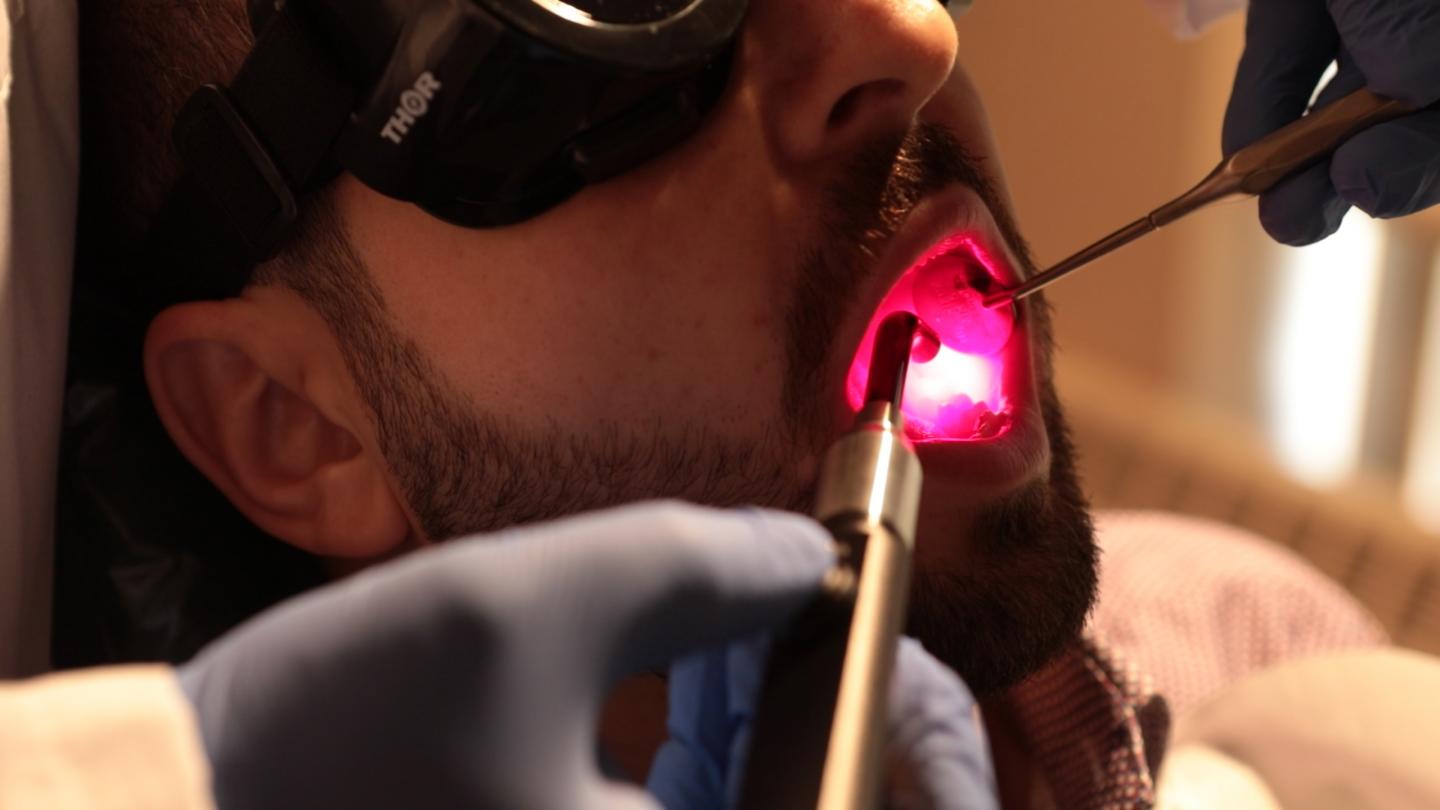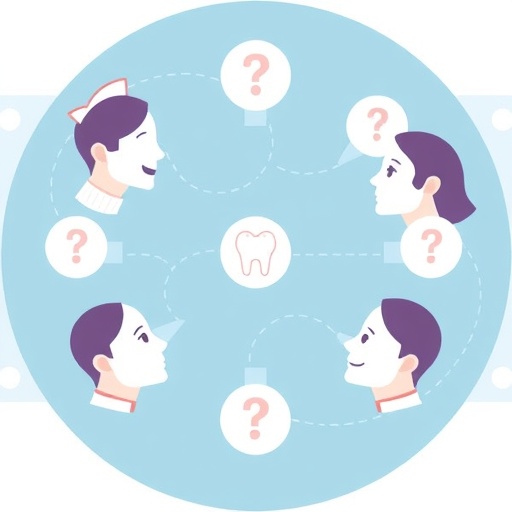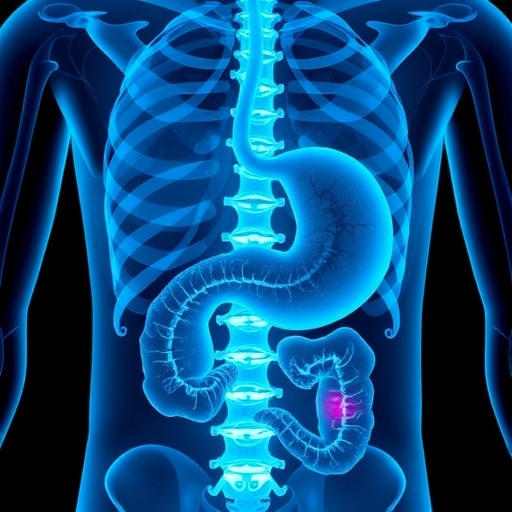Light therapy has potential to replace opioids in treatment of mucositis, a common side effect of chemotherapy and radiation therapy

Credit: Douglas Levere, University at Buffalo
BUFFALO, N.Y. — University at Buffalo researchers have received part of a $1.5 million grant to investigate light therapy as a replacement for prescription opioids in treating oral mucositis, painful ulcers and swelling in the mouth that result from chemotherapy and radiation treatment for cancer.
Funded by the National Institutes of Dental and Craniofacial Research Small Business Innovation Research program, the grant will help researchers determine the effectiveness of photobiomodulation, a form of low-dose light therapy, in prevention and treatment of oral mucositis after cancer treatment.
The grant was awarded to Cleveland-based MuReva Phototherapy, a spin-off company of lighting solutions manufacturer Lumitex, to further develop the light technology. UB received $511,000 of the award to test the technology.
Video: https:/
The research, led by Praveen Arany, DDS, PhD, assistant professor in the UB School of Dental Medicine, will be performed in collaboration with faculty from the Departments of Radiation Medicine and Oral Oncology at Roswell Park Comprehensive Cancer Center.
“The current epidemic of opioids has impacted cancer care, especially for cancer pain relief. This treatment offers a simple, non-drug, non-invasive treatment approach to relieve pain and improve quality of life for cancer patients,” says Arany.
“The striking lab and clinical evidence for photobiomodulation treatments in supportive cancer care has demonstrated tremendous promise and is becoming popular.”
The worst side effect of cancer
Oral mucositis is caused by damage to mucous tissue from chemotherapy or radiation treatment, or stem cell transplant. The condition occurs in close to 40 percent of patients receiving chemotherapy and nearly 80 percent of patients receiving radiation therapy for cancer, according to the Centers for Disease Control. Nearly 70 percent of those receiving stem cell transplants develop mucositis, adds Arany.
Multiple studies have found that patients report oral mucositis as the worst side effect of their cancer treatment. Pain from the condition can slow or delay treatment, and in severe cases require hospitalization and feeding tubes.
“In addition to the pain, it compromises a patient’s ability to eat and swallow, and may even interfere with their planned treatment,” says Mukund Seshadri, DDS, PhD, professor and chair of the Department of Oral Oncology at Roswell Park.
“Given these significant adverse effects on the quality of life in our patients, it is a high priority for us to find new and better ways to prevent or treat this condition.”
“Right now, opioids are the most commonly prescribed drugs to address those symptoms, but they come with a whole host of problematic side effects of their own, including the potential for addiction and abuse,” adds Anurag Singh, MD, professor of oncology and director of radiation research at Roswell Park and professor of medicine in the Jacobs School of Medicine and Biomedical Sciences at UB.
“So we have been looking at a number of ways to treat those symptoms while limiting the need for opioids, including photobiomodulation.”
Light as a solution
Light therapies have existed for decades, but improvements in the technology have made the treatment more affordable for wider use, says Arany.
At a high power, light, often in the form of a laser, is used in medicine to cut or destroy tissue. But at a low level, it has the ability to relieve pain and promote healing.
The effectiveness of photobiomodulation in treating pain and stimulating healing has been documented in hundreds of clinical trials and thousands of academic papers. The treatment is used widely across Europe, Canada, Australia and several other nations. Consensus has not, however, been reached on the proper dosage for the treatment, says Arany.
Using the technology developed by MuReva Phototherapy, UB and Roswell Park researchers will examine the effectiveness of photobiomodulation treatments for oral mucositis, as well as determine the proper dosage to limit pain and stimulate healing in tissues damaged by cancer treatment.
“Current approaches for delivering a photobiomodulation-utilizing laser for oral mucositis requires a physician to spend 30 minutes per patient, per day, and is too impractical an approach for mass adoption,” says Vedang Kothari president and CEO of MuReva Phototherapy.
“MuReva’s innovative mouthpiece that can be self-administered, simultaneously targets a much larger portion of the oral cavity and delivers a full treatment in six minutes or less. We believe this technology has the potential to revolutionize the treatment for oral mucositis and finally present a market-ready solution to this debilitating side-effect.
“We are excited to partner with the University at Buffalo and esteemed clinician and professor Dr. Praveen Arany on this cutting-edge research. We believe that strong industry and academic relationships are important to advance innovative technologies to the marketplace.”
Arany, also president of the World Association for Photobiomodulation Therapy and co-chair of the committee on light therapy for supportive oncology care of the Multinational Association of Supportive Care in Cancer, is an advocate for wider use of photobiomodulation in the United States.
He recently took part in the first Congressional briefing on photobiomodulation before the House Science, Space and Technology Committee in Washington, D.C. The briefing, held on Oct. 11, 2018, invited a panel of international experts on the therapy to discuss the potential of photobiomodulation to improve health care and lower dependence on opioids.
“The ability of low-dose light therapy to promote healing has been established since the 1960s,” says Arany.
“A major obstacle with its wide spread use has been a lack of understanding of its precise biological mechanism. Recent work from our group has outlined both therapeutic and dose-limiting molecular pathways that are aiding development of safe and efficacious clinical protocols.”
###
Media Contact
Marcene Robinson
[email protected]
716-645-4595
Original Source
http://www.




